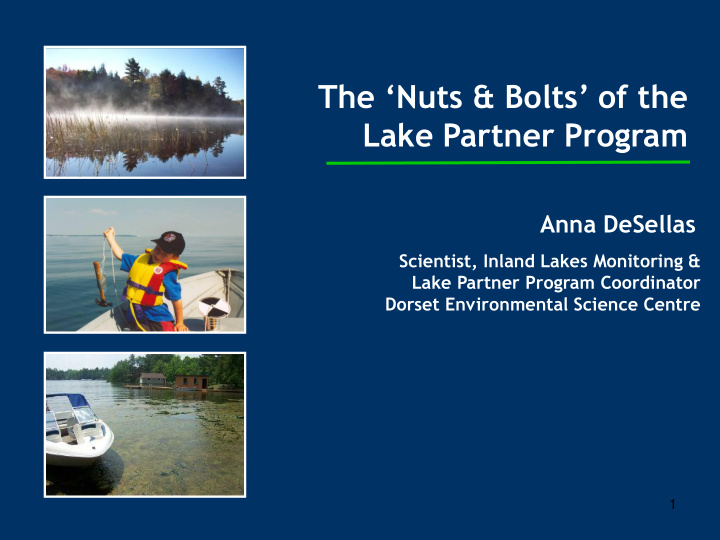



The ‘Nuts & Bolts’ of the Lake Partner Program Anna DeSellas Scientist, Inland Lakes Monitoring & Lake Partner Program Coordinator Dorset Environmental Science Centre 1
Phosphorus and water quality Phosphorus: • A nutrient that is essential to aquatic systems and for organisms that inhabit them • It is the “limiting” factor that controls the rate at which plants and algae grow Aulacoseira sp. (a diatom)
In excess quantities, phosphorus can contribute to algal blooms Algal blooms can: 1) Reduce water clarity (Photos: Bev Clark) 2) Reduce deep-water oxygen 3) Produce toxins 4) Cause “bad” taste and odour
-watershed Sources of TP to lakes - atmosphere - erosion - lake sediments - septic/sewage/fertilizers
What role does phosphorus play? • 1960-1970s – algae increased and water quality decreased in some Ontario lakes • Why did water quality decrease? • The next slide shows that phosphorus influences the frequency of algal blooms and the amount of aquatic vegetation.
1970s – Phosphorus became important Carbon & Nitrogen only Barrier Carbon, Nitrogen AND Phosphorus ALGAL BLOOM! Experimental Lakes Area, NW Ontario 6
• In Ontario, we frequently manage our lakes based on phosphorus • We know that as phosphorus increases, the frequency of nuisance algal blooms increase 7
The main thing that separates lakes with respect to their “character” is nutrients, especially phosphorus. TP Oligotrophic Lakes Dystrophic (tea stained) lakes 10 µg Mesotrophic Lakes 20 µg Eutrophic Lakes
Different types of lakes Shallow, productive (warm water) lakes - mixed to bottom - productive (fish etc.) - more algal blooms - off shield lakes
Different types of lakes Deep, unproductive (cold water) lakes - stratified in summer - unproductive - clear water - no algal blooms - shield lakes - lake trout lakes
Different types of lakes Dystrophic (tea stained) lakes - different “chemistry” - high DOC - carbon from watershed - mostly shallow - poor light penetration - usually no algal blooms
Lake Partner Program Objectives 1) protect the water quality of Ontario’s inland lakes by involving the public in a volunteer-based water quality monitoring program; 2) to maintain a database of nutrients (total phosphorus) and water clarity (Secchi transparency) (and calcium since 2008); 3) to help volunteers… a) define the trophic status of their lakes; b) ‘normal’ between -year trends in phosphorus and water clarity 12
People Involved • Currently coordinator (Anna DeSellas), Assistant Coordinator (Christie Davies), and one university co-op student (shared with another program) each summer and fall • Volunteers (>600) and Science Partners (~15) collect water samples and data • Chemistry staff at DESC perform analyses • Important partner, Federation of Ontario Cottagers’ Associations (FOCA) contributes through promotion, education and stewardship 13
Timeline Lake Partner MOE’s Lake Program of the Partner Program Eutrophication 21 st century evolved became an important water MOE started the Lake Partner quality issue Self-Help Program Program moved to Dorset 1960s-70s 1970s-1980s 1996 2001 2012 - precise TP - volunteer lake -Algae - volunteer lake analysis and stewards stewards -Water clarity duplicates - partnerships with - chlorophyll-a and - Overall water -Volunteer FOCA, DMM, LOWDPOA water clarity quality numbers continued (Secchi) - TP (low precision) to increased and water clarity - MOE Toronto office 14
Parameters measured (2002-present) Calcium (since 2008) Total Phosphorus (TP) Secchi transparency • Declining • Controls the growth • Estimation of water concentrations in many of algae in Ontario clarity Ontario shield lakes Lakes • DOC often masks (~80% < 10mg/L) TP/algal relationship • Some daphniids and • Useful to detect other crustaceans changes resulting sensitive to decline from ‘other’ stressors On Shield Lakes: spring turnover [TP] in May Off Shield Lakes: monthly [TP] 15 Bi-weekly, May-Oct Deep spot, 1x Secchi depth
Program Extent – CHA Region 16
3 Rinse 2x with filtered 1 Sample kit 2 In May , Measure 4 Filter lake water , obtain an (arrives in winter) and Record Secchi with 80-µm integrated water sample, depth at deep spot 1x Secchi depth to mesh surface Lake Partner Program Sampling Protocol 7 Affix 9 Data posted return online after postage QA/QC and mail to DESC 6 Fill 5 Fill 2 glass plastic jar tubes on site 8 Analysis at DESC chemistry lab 17
Duplicate glass TP Shipping box tubes with etched Plastic sampling line at 35 mL bottle Plastic jar for Ca analysis (and Secchi Disk contingency) Funnel with filter mesh (80 µm) Return envelope and postage Secchi disk recording sheet 18 and instructions
A note about sampling equipment There are a few things the volunteer must provide: • Large washers, nut, eyebolt for Secchi Disk; • Anti-stretch rope (max 10 m; marked every 10 cm); • Weight for sample bottle: 900 g (2 lbs) is enough to provide negative buoyancy (to avoid biasing the sample to surface water). 19
Other considerations… Canadian Shield • Why do we sample in the spring only in most Shield lakes? 20
On-Shield vs. Off-Shield monthly TP trends Chub Lake, 2005 25.0 20.0 [TP] (µg/L) 15.0 10.0 5.0 0.0 May-05 Jun-05 Jul-05 Aug-05 Sep-05 Oct-05 Nov-05 Month ON SHIELD Aberdeen (Bass) Lake, 2007 25.0 20.0 [TP] (µg/L) 15.0 10.0 5.0 0.0 May-07 Jun-07 Jul-07 Aug-07 Sep-07 Oct-07 Month OFF SHIELD 21
Spring vs Monthly sampling OFF SHIELD ON SHIELD • Monthly sampling • Spring sampling • Generally they are susceptible • Shield lakes with blooms – monthly to algal blooms (these are rare) • Shield lakes in northwestern Ontario – monthly (higher TP) R. Ingram T. Sellers 22
Join the Ministry of Environment’s Lake Partner Program! Web: www.desc.ca/programs/lpp Email: lakepartner@ontario.ca Phone (toll free): 1-800-470-8322 Outside Ontario: 705-766-1294 Visit FOCA’s website and watch their great training video! http://foca.on.ca/lake-partner-program-sampling-assistance/ 23
Recommend
More recommend